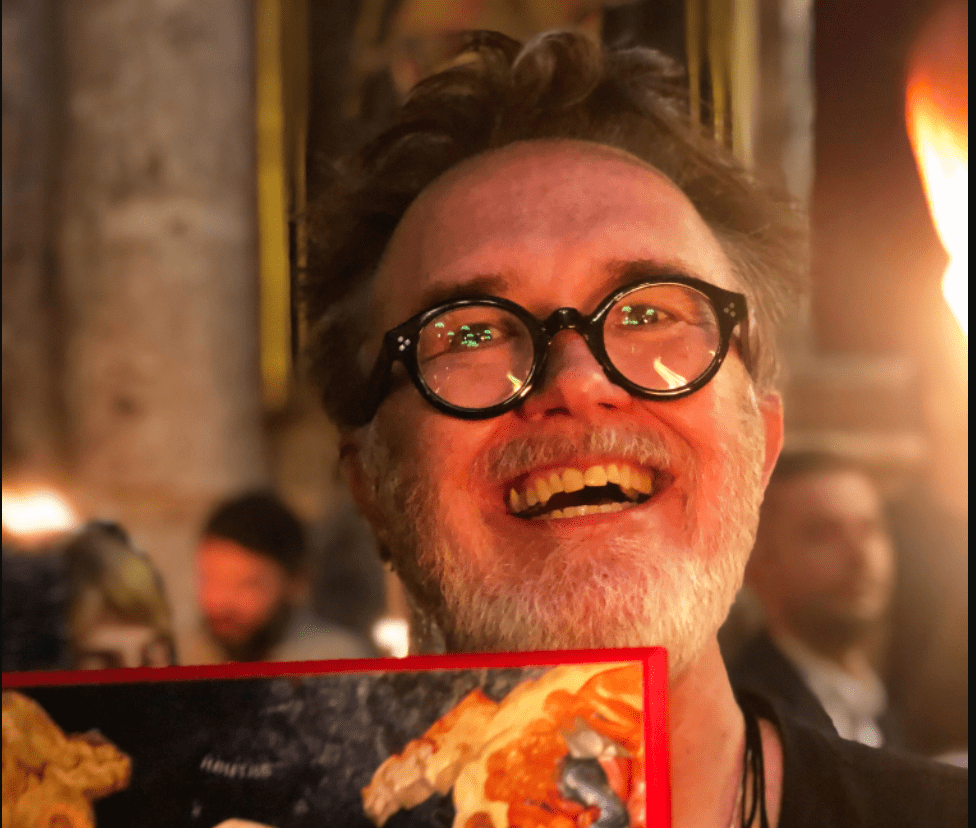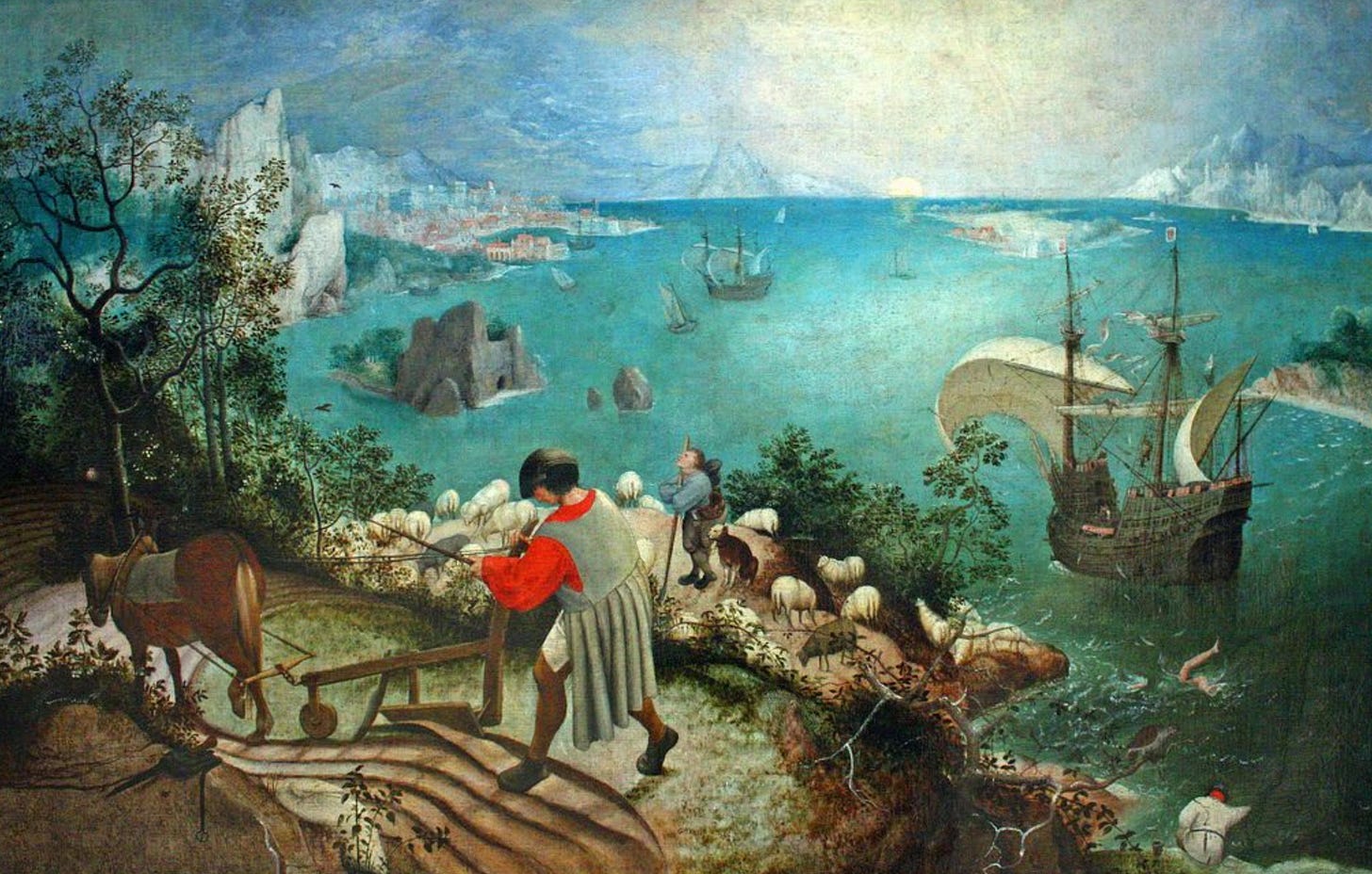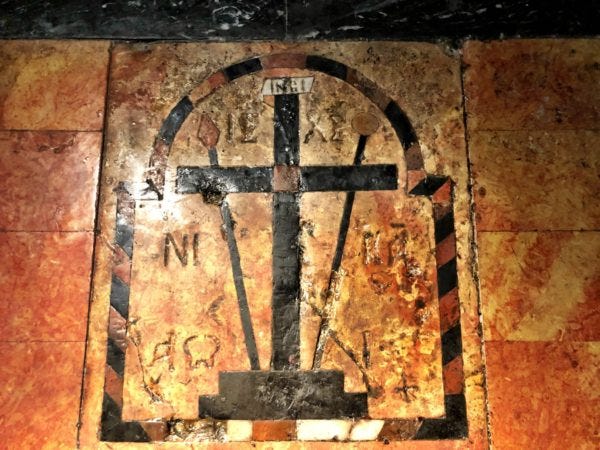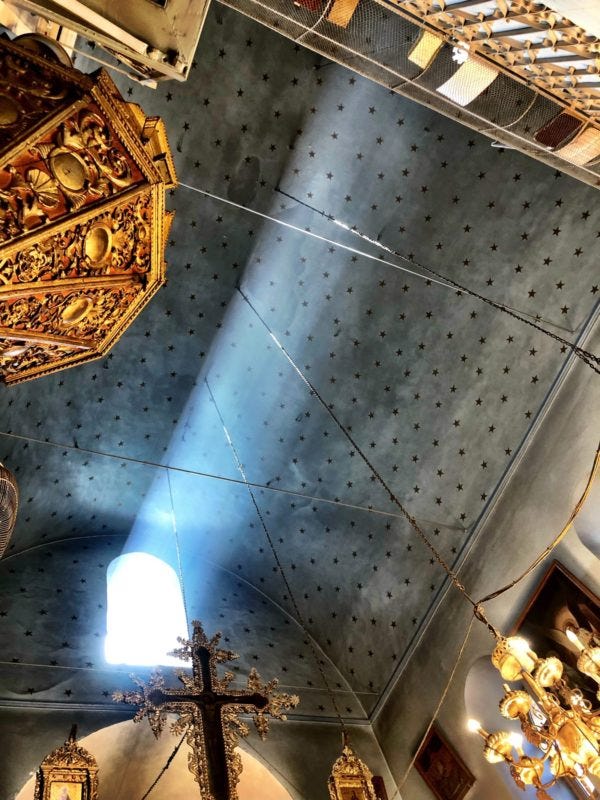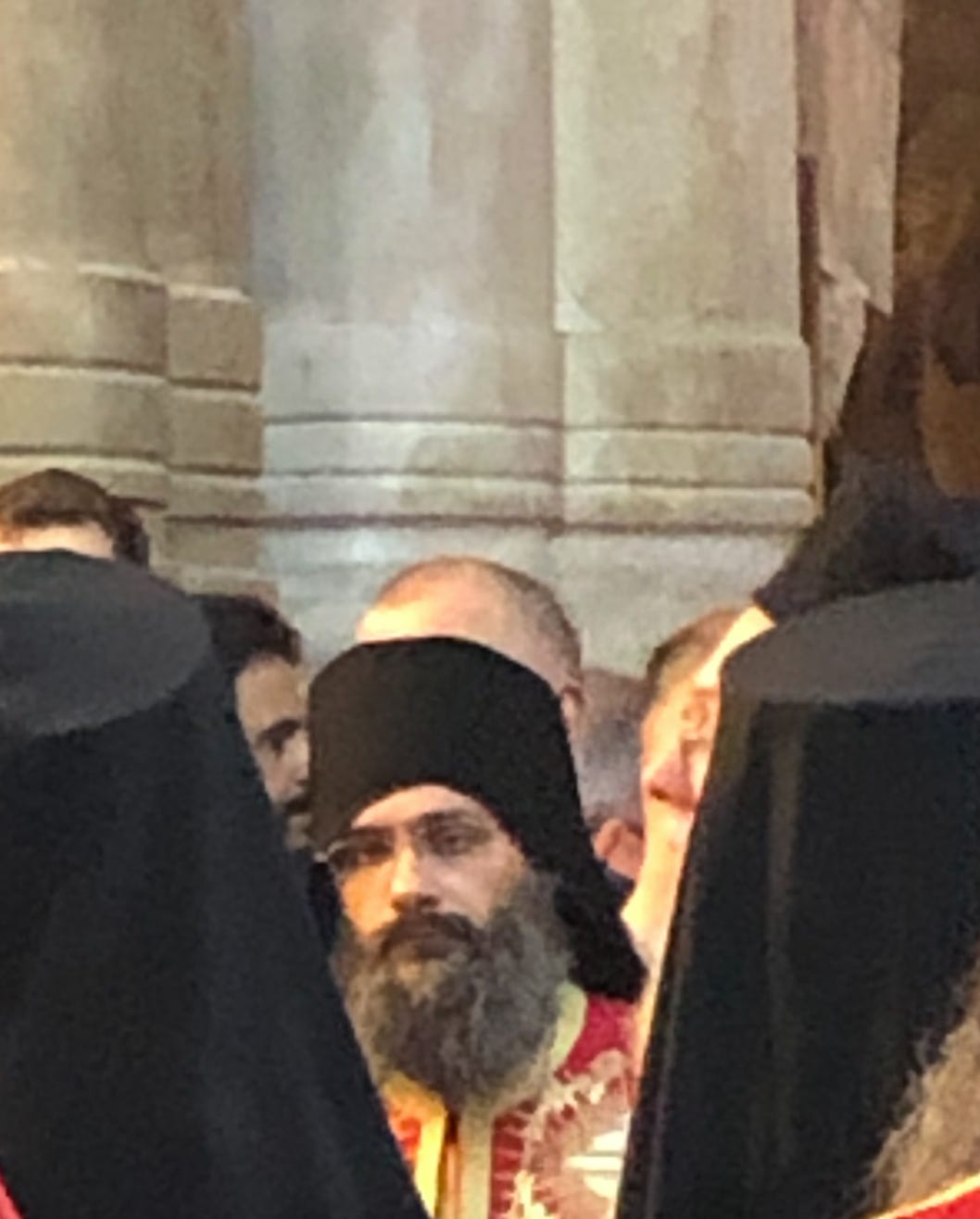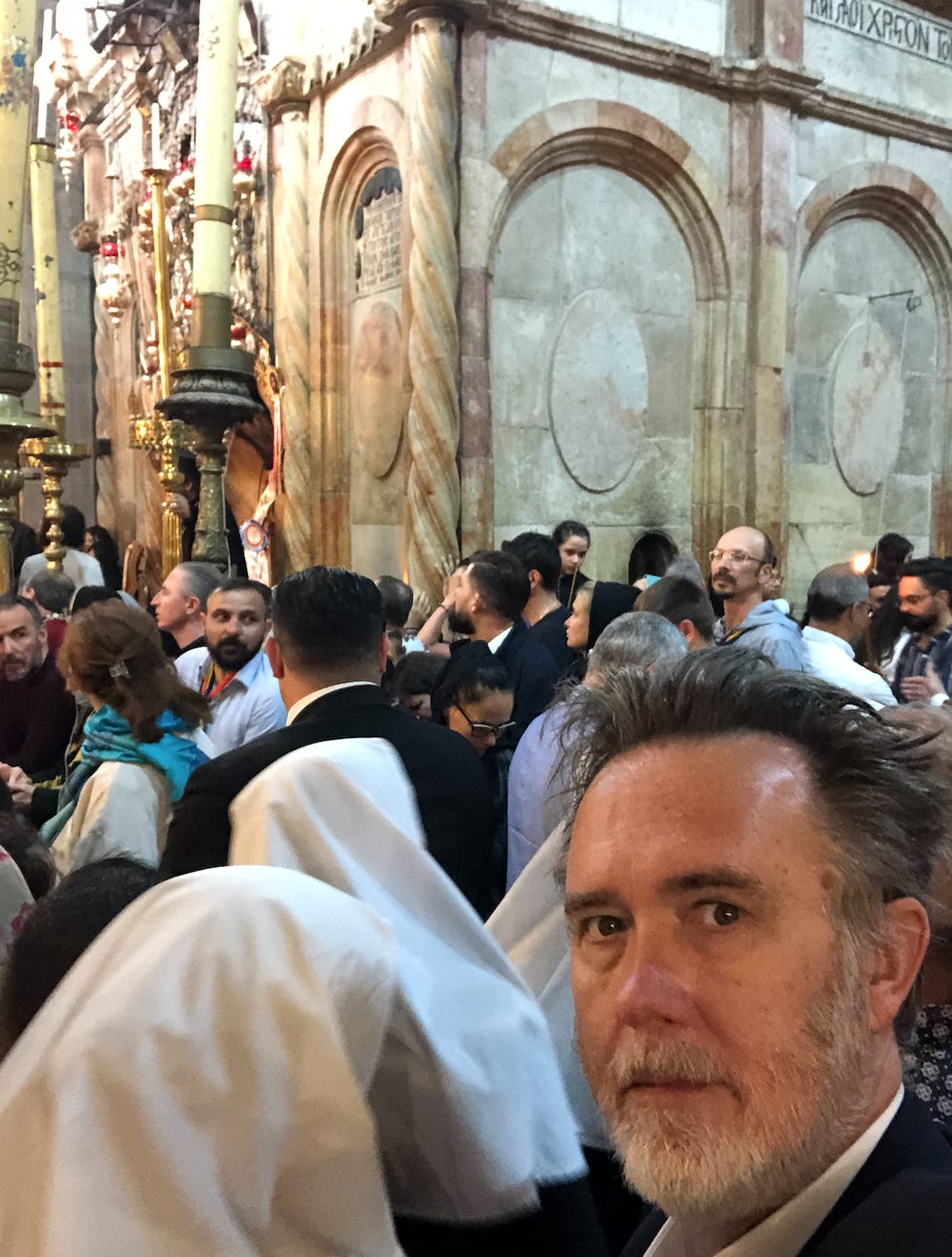T.S. Eliot said famously that April is the cruelest month. I will always remember April 2022 as the month that my wife announced that she has filed for divorce. Yet after the initial shock wore off, I realized that her decision was both correct and courageous. After nine long and grueling years of trying to save this marriage, I believe she made the right decision to end our mutual torment. As I’ve said, we agreed not to talk about the things that brought us to this point, but most of our closest friends, including at least one of the two priests who have counseled us over the years, believe that it is a sad necessity. I’m not kidding when I say that I have great respect for my wife for her decision, compassion for the suffering that led her to make it, and sorrow for the role I played in the breakdown of our marriage. I spent a good part of Holy Week in Jerusalem praying for her, that she — and I — can find peace and healing.
How tragic life is. When I lost my Catholic faith around 2005, the greatest shock for me was the realization that no matter how hard one tries to hold on to faith, it can be pulled out of one. I really did believe that one’s faith commitment was strictly a matter of willpower, but I learned that that isn’t true. In 2007, Bill Lobdell, the former religion reporter for the Los Angeles Times, wrote an essay about how covering church scandals cost him his faith. You should read it. Excerpts:
It took several years and numerous memos and e-mails, but editors finally agreed in 1998 to let me write “Getting Religion,” a weekly column about faith in Orange County.
I felt like all the tumblers of my life had clicked. I had a strong marriage, great kids and a new column. I attributed it all to God’s grace.
He began the process to convert to Catholicism, but broke it off:
At the time, I never imagined Catholic leaders would engage in a widespread practice that protected alleged child molesters and belittled the victims. I latched onto the explanation that was least damaging to my belief in the Catholic Church — that this was an isolated case of a morally corrupt administration.
And I was comforted by the advice of a Catholic friend: “Keep your eyes on the person nailed to the cross, not the priests behind the altar.”
More:
I couldn’t get the victims’ stories or the bishops’ lies — many of them right there on their own stationery — out of my head. I had been in journalism more than two decades and had dealt with murders, rapes, other violent crimes and tragedies. But this was different — the children were so innocent, their parents so faithful, the priests so sick and bishops so corrupt.
The lifeline Father Vincent had tried to give me began to slip from my hands.
I sought solace in another belief: that a church’s heart is in the pews, not the pulpits. Certainly the people who were reading my stories would recoil and, in the end, recapture God’s house. Instead, I saw parishioners reflexively support priests who had molested children by writing glowing letters to bishops and judges, offering them jobs or even raising their bail while cursing the victims, often to their faces.
All too familiar to me. Lobdell writes about covering a Protestant scandal, and about how seeing the human wreckage religious leaders and people caused, his faith finally simply left him. I was fortunate: I didn’t stop believing in God, only in the truth claims of the Catholic Church. When I became Orthodox, I resolved to become a very different kind of Christian. My intellectualism, and the intellectual certitude I brought to my relationship with God, had been not a source of strength, but of weakness. The utter humiliation of my losing my Catholic faith changed me. I hope it made me a better Christian. Only God knows, though.
Similarly with marriage. Honestly, I never imagined that I could lose my Catholicism. Nor did I imagine that I could lose my marriage. Yet here I am, after years of pain and disillusionment, among all the broken people — people who once thought that as long as they believed all the right things, and had the best of intentions, they could avoid the worst. Nope. I fought even harder for my marriage than I did for my Catholicism, and suffered excruciating pain for over twice as long in this failed marriage than in my failing commitment to Catholicism. It ended up in the same place.
And yet, this morning, back in Budapest, I ran into a Danube Institute friend and colleague on the street. She had not heard about the divorce. We talked for a while, and she noticed how calm, even happy, I was.
“How on earth are you doing this?” she said, referring to my demeanor.
“Entirely by the grace of God,” I said. “Christ healed my heart in Jerusalem. I’ll tell you the story when we have more time.”
It really is true. I told my blog readers last week about the extraordinary thing that happened to me in a dark crypt chapel of the Church of the Holy Sepulcher. If you missed that essay, here’s a link. I began by talking about how I couldn’t find the church in the Old City where the Holy Thursday liturgy was happening. Frustrated, I decided not to go back to bed, but over to the church built over the place of the death and resurrection of Jesus Christ. Excerpts:
Eventually I found my way to the Holy Sepulcher church, crossed myself at the threshold, and went in. Maybe the liturgy is at the Katholikon, in the center of the church? No, it was closed. Well, I thought, I guess I’ve missed it. But I didn’t want to miss another opportunity to pray in the holiest place on earth for us Christians. I decided to walk to a part of the sprawling old basilica that I had never seen.
I ventured into a crypt, where the Armenians have a chapel. It was still early in the morning, and very few people were in the church. No one at all was down here. I looked for a place to pray, and was drawn to a dark chapel to the right of the altar. I walked in, looking for a bench on which to sit and pray.
There were no benches, but I did see this mosaic on the floor:
I went on my knees, crossed myself, kissed it (though I didn’t know what I was reverencing, except the Holy Cross), then traced the Alpha and Omega with my fingertip. I realized that I was at the base of the Golgotha hill, which rose behind the basilica wall on my right. I stayed there in prayer for a few minutes, but then a couple of men came into the area, and were a bit noisy, so I moved back to the main chapel in the crypt, found a bench, and sat down to pray.
The entire church was eerily still, and my heart began to resonate with the unearthly silence. I realized at once that I was in the Chapel of St. Helena, who supposedly found the True Cross on the same journey that she found the Tomb of Christ. Then I realized that the rock I reverenced must be the traditional marker for the place where she discovered the Cross. (Whether she really did find it there or not is beside the point; that’s where that event is marked.) Suddenly I became aware of a presence around me, and a voice in my heart, speaking clearly. Normally I turn on my skeptical mind when something like that begins to happen, and it scares whatever it is away. This morning, though, I was so still that I just let it go.
The inner voice — that calming vocal presence — told me several things. One of the things it told me was that I was at the end of a journey. I had been praying for a long time, wondering what the sword in the stone meant.
You readers of this newsletter know all about the Sword in the Stone aspect of my story. There in the crypt chapel, I realized that the Lord had been calling me — via the mysterious intervention of an Italian artist, and the strange advent into my life of a Tarkovsky film — to make a total sacrifice of my future happiness, to preserve the marriage. I had come to understand that my obsession over the lost happiness of my marriage had paralyzed me, and had done so for years. But I couldn’t shake it. I knew that the marriage was irrecoverable, and had known it for years, but I loved so intensely what we had had for sixteen years, and loved my children so much, that I could not let go of its memory, and praying for its restoration.
Earlier this April, I had gone to a Romanian monastery on retreat, and had decided there once and for all to place all my hope in God, and to make a sacrifice of my future for the sake of doing His will, and remaining in this marriage. I left the monastery resolute — not happy, because making that vow required accepting that the rest of my life would be lonely and painful. But I did it for Christ, and for my children. I was at peace.
A week later, my wife filed for divorce. More:
Now, you might think that makes me look more noble. Wrong! In retrospect, and in light of a lot of facts I’ve been thinking about this week, I sincerely think Julie made the braver and more intelligent choice, and that the Lord has worked for us both, through her choice, a severe mercy. But I had to make the choice I did, for reasons that will soon become apparent.
The morning after I found out that my wife was divorcing me, I came to Jerusalem. I have spent a lot of time atop Golgotha, praying for her, praying for me, praying for our kids. I have been grieving. God has given me an ability to see my wife as someone who has been suffering greatly too. I have not been able to muster anger at her. We are just so unbelievably exhausted from all this. Nine years of it.
So: as I sat in that silent crypt this morning, I thought about the sword in the stone, then I remembered that today is Holy Thursday, the day that Jesus Christ was taken in the Garden of Gethsemane to his trial. On this night, Peter drew his sword to protect the Lord from his enemies, but Jesus told him to put it away, and surrendered to his fate. Jesus knew that what was about to happen had to happen for all righteousness to be fulfilled.
I heard the inner voice say to me that now was the time to put away my sword — that is, to stop fighting for a restoration of the past. In fact, said the voice, I had done that at the monastery. I had made the long nine-year journey across the empty bath with the flame alight; now I needed to place it on the stone and be free. Then it hit me: that stone where I had just been praying was the stone that marks the spot (traditionally, if not necessarily literally) where the Romans discarded the Cross. The inner voice was telling me that the fight was over, that what was about to happen — meaning the dissolution of the marriage — had to happen.
But why? I asked. Why not just restore the marriage?
I didn’t wait for an answer, but banished the questions. I may never know, and that’s beside the point. Why did Jesus have to suffer and die? We are dealing with the deepest mysteries here.
The voice said to me that he was with me throughout the long walk across the desertified pool, and would be with me always. He — because I was pretty sure that it was Jesus — told me, “I will send my brother James to help you.” And then: “And I will send you a sign: where you see the stars, there I am.”
Then the episode ended. I rose and went back to the stone in the Finding of the Cross chapel. I knelt down, kissed it, and left my sword there, buried in it, at the foot of Golgotha. I turned and walked out, a free man. The knot that had been tied so tightly in the cords of my heart untangled itself. I was light as a feather. I felt born again. Now I was walking in the joy of the Lord.
I am returning to a world of pain and brokenness as the disassembly of my marriage and life as I knew it begins. But I know that God is in this. I don’t just believe it; I know it. I know that He won’t abandon us. I know that somehow, for reasons that we may never understand, He allowed this horrible thing to happen for some greater good that can come if we cooperate with it. The same Lord who turned his shameful, bloody, violent death on the Cross into the cosmic victory over death is at work in our grievous divorce, to redeem it from the jaws of sin and death.
I climbed the twenty-nine steps out of the crypt and into the light of new life.
Somehow, I thought, something about my willingness at the Putna monastery in Romania to make that sacrifice must have jarred something loose in the spiritual world. I don’t know; maybe so. I couldn’t understand why I felt so light, then it occurred to me that I had left my cross in the same place, symbolically, where Jesus had left His.
That was it. That was my healing miracle.
I walked out of the church in a joyful daze. But was there a liturgy anywhere? Where is this St. James Cathedral? Standing in the small plaza outside the Church, I saw a stout, grey-bearded Greek priest passing.
“Where is the liturgy?” I asked.
He pointed to a doorway nearby, then passed through it. I followed, then saw the sign saying that this is St. Jacob’s Cathedral. Of course! “James” is the Anglicization of “Jacob”. The English translation from the Greek Patriarchate had not taken that into account. When I arrived into the cramped cathedral (really the size of a small church), one liturgy had ended, but one celebrated by Patriarch Theophilos had begun. As I pushed my way into the jam-packed nave, I looked around, then up. This is what I saw:
The ceiling covered with stars! And then, a few minutes later, out from the altar came Patriarch Theophilos to bless us:
I thought: there is James! James, the stepbrother of the Lord (St. Joseph’s son by his first marriage), was the first bishop of Jerusalem. Patriarch Theophilos stands in an unbroken line of succession back to St. James. You know how Catholic sometimes call the Pope “Peter”? This man you see there is James. The Lord sent him to me, under a canopy of stars, to confirm that what had just happened to me in the crypt was real, and that I could believe in it confidently. That is my conclusion. I imagine the light pealing off my face the moment I realized that could have illuminated the entire church.
One more passage from that post:
If I had known where to go for the liturgy this morning, I never would have wandered around the Church of the Holy Sepulcher. I never would have found that cave chapel. I never would have prayed silently there under the earth, amid the limestone. And I never would have heard the still, small voice tell me: you’re free.
I don’t know what comes next. I do know that I need to go back and try to share some of this unmerited grace with my wife, who needs to taste the same freedom and healing that Christ gave me. Jesus has made it possible for me to go home without resenting, or mourning, or in a spirit of destruction, but rather in a spirit of peacemaking and love and rest. How? How did this come to me? I have no idea, but I will not stay stuck in my head and refuse it because it came so suddenly, and doesn’t make sense so soon after the horrible stroke of the divorce announcement.
I went back to my hotel room and wrote down everything that had just happened, because I wanted to share the good news of hope and resurrection. Without Christ, I could do nothing. Somehow, through all the pain of brokenness, the brokenness caused by my sins, my wife’s sins, and the sins that persisted across generations of our families, Jesus was there. Jesus is there. He has not abandoned us. I testify to His love.
What happened the rest of my time in Jerusalem? Well, I went to the Holy Fire ceremony on Saturday, as I wrote about here. Was it a miracle? I am skeptical, but again, I can tell you that I was able to pass my hand through the flame unharmed for the first two or three minutes it blazed in my hands. Five minutes later, this was impossible. My Serbian friend said he allowed the flames to lick his bare face, without incident — but after five minutes, this was impossible, because the fire burned him.
After a long nap, I arose and got dressed to go to the Paschal liturgy at the Church of the Holy Sepulcher. I got lost in the dark warrens of the Old City, and had no idea where I was. I was in one of those shadowy alleys, and saw a man standing there in the darkness. What if that’s an angel? I thought. Of course it wasn’t — he was just a shopkeeper — but I wondered what it would be like if the Lord sent me an angel on this holiest of nights.
I turned around and retraced my steps, and who do you think I saw next? Angela, the chambermaid from the Gloria Hotel, where I was staying! She was the dear Arab Christian woman who reduced me to tears in the hotel hallway when she gave me her simple cross on Good Friday.
“Angela!” I said, and rushed over to hug her.
“Are you okay?” she asked.
“Yes, thanks to God, more than okay.”
“Thanks God!” she said.
She introduced me to her brother, standing at her side. I told him, “Your sister was an angel sent by God to comfort me.”
She told me the right way to go to get to church, and off I went.
The Patriarch of Jerusalem led the Orthodox service, conducted inside the edicule, at the very tomb of Our Lord. I stood there for five hours, with fellow believers, awaiting the Lord’s resurrection. Among the faithful was Father Timotei, a monk of Putna, where I had made my commitment:
Here I am near to the Lord’s tomb that night:
Finally, at four in the morning, it was over. Just before the ceremony ended, I caught a glimpse of the Patriarch in the edicule, behind an altar. He looked like the Ancient of Days, and it was glorious. Christ is risen from the dead, trampling down death by death, and upon those in the tombs bestowing life. I look forward with the hope that in paradise one day, all the enmity between my wife and me will disappear, and we will meet again with pure love, in Christ.
On Easter Sunday, I went to the Western Wall of Herod’s Temple to pray for a Jewish friend, and for the Jewish people, and for all God’s suffering children of this holy land:
Then I did something painful but, I think, necessary. I went back to the Holy Sepulcher, and to the crypt chapel where the Lord spoke to my heart on Holy Thursday. I had one more thing to do. When I arrived there, crowds of boisterous tourists bumped around, all trying to bend down to touch the stone. I stood back waiting my turn, and I prayed. I thanked the Lord for my marriage — for the sixteen good years, and even for the nine bad ones, because surely He was in them, and used them as a spiritually refining millstone. I don’t know what He has done with me through that suffering, but I know at least He has taught me to be more compassionate. I thought marriages going bad, and divorce, was something that happened to other people — people who didn’t have enough faith or virtue. I was wrong. I had sacrificed; now I depended on His mercy. I need to find a way to be a vessel of His mercy to others.
I knelt down before the stone, removed my wedding ring for the last time, placed my the golden band at the foot of the Cross, touched my forehead to the rock, and said, “The Lord gives, and the Lord takes away. Blessed be the name of the Lord.” Something like Andrei with his candle in Nostalghia, I ended the twenty-five year journey of my married life by placing the ring the rock. I rose, put the golden band in my pocket — the kids might want it one day — and turned to rise up the staircase into the light.
I looked back one last time to see the stone, and observed the tourists elbowing each other absurdly to reach it. They had no idea what had just happened in front of them: the symbolic end of a long marriage. And I laughed at my self-importance, thinking of Auden’s lines from Musée des Beaux Arts:
In Breughel’s Icarus, for instance: how everything turns away
Quite leisurely from the disaster; the ploughman may
Have heard the splash, the forsaken cry,
But for him it was not an important failure; the sun shone
As it had to on the white legs disappearing into the green
Water; and the expensive delicate ship that must have seen
Something amazing, a boy falling out of the sky,
had somewhere to get to and sailed calmly on.
